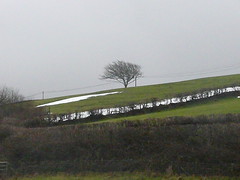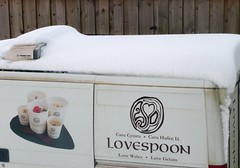I remember a story from my childhood……
Entitled ‘How the Bee Became’ it recounted the story of how whilst God was making all the animals, birds & insects to populate the Garden of Eden, he was spied upon by a hideous, one-eyed ogre who lived in the very bowels of the earth. Jealously convinced that he could make something to rival the finest of God’s creatures, the ogre collected myriad jewels he had mined & ground them into a fine powder. But he didn’t have any water to turn it into clay. He was so upset that he wept in frustration & one great big tear rolled from his eye & dripped into the bejewelled dust….
Excitedly the ogre hastily worked the tiny lump of clay until he had fashioned it into a fragile little creature with delicate, iridescent wings. He baked the little model in the heart of the nearest volcano; & afterwards took it up to the daylight at the entrance of his deep, dark cave so that he could admire it in comparison with the creatures God had created.
Feeling boastful he called God over to view the pretty little thing. “Why, it’s delightful!” God exclaimed, turning over the little clay figure the palm of his mighty hand.
“What a shame it will never live, though,” sighed the ogre. “Such a pretty thing should surely live & breathe; but alas, I don’t have your gift to make it so.”
“Well, I can soon see to that,” God retorted cheerfully. And so saying he held the tiny thing to his lips, & blew gently upon it.
“Buzz”, said the little creature, stirring her stiff wings. “I shall call you ‘Bee'”, smiled God.
Abruptly the ogre snatched his creation from God’s gentle grasp & scuttled, cackling, back into the bowels of the earth. There he played with the little Bee for hours on end, letting her hop from grubby finger to grubby finger, admiring the rainbow colours glinting from her wings in the glow of the subterranean firelight & delighted he had created something to rival even the prettiest of God’s menagerie.
But the Bee was unhappy. The blood which coursed through her veins was the liquid of tears; & she mourned the lack of the sunlight beneath which she had taken her first breath. Abruptly she flexed her wings. “Buzz”, said the Bee. And she flew away, up, up towards the sunlight & to salvation.
“Come back!” roared the ogre in angry, unhappy frustration. “COME BACK! PLEASE!!” & with that he hurtled up the tunnel after the little Bee, whose heart was thumping in her chest almost as fast as her wings were beating her escape. She flew from the entrance of the cave & up into the beautiful blue sky, just as the ogre made one last, desperately futile lunge – after which he scuttled back into the bowels of the earth, afraid of God’s wrath for what he had done.
The Bee was free. But although the warm sun cheered her, soon the desolation of sadness coursing through her veins caught up again. With a sigh she alighted on the colourful pillow of a flower; & discovered a sweet, delicious taste – nectar. It was so ambrosial that she was swept up in a wave of pleasure & for a while, forgot all about her sadness. And when that sadness overwhelmed her again, she would fly to another flower to sip the sweet nectar & so forget her woes.
And that is how the Bee became; & why, to this day, she flies from flower to flower, seeking solace in sweetness.
But there is a disturbing twist to this charming tale. Either the bees are getting happier as their tearful blood dilutes with nectar as time goes by; or their populations are actually declining dangerously. Whilst on the surface this may not appear to be the case, with every summer meadow apparently a literal hive of activity, the experts assure us that bee numbers are reducing every year. This is owing to a variety of factors – poor weather; fungal infections; mites; loss of habitat; & the mysterious & worrying Colony Collapse Disorder (CCD) which with our local supplier alone, has accounted for the death of around 140 colonies during the season.
Due to a drastic decline in the global bee population in recent years, the Honey Association has predicted the gloomy news that British honey will have run out by Christmas – & won’t return to the shops until next Summer. And the disappearance of British honey is the mere tip of the iceberg…..
Tim Lovett, President of the British Beekeepers’ Association paints a gloomy picture. “Without bees there would be no jam, no honey, no fruit & very few vegetables,” he declares starkly. “Our diet would be considerably less interesting, & the Government could forget all about its ‘five-a-day’ campaign.”
Bees are responsible for pollinating (either directly or indirectly) around a third of the food we eat: as well as major fruit crops, which depend on honey bee pollination to varying extent (90% for apples; 30% for raspberries & pears; 10% for cherries & strawberries), runner beans are 40% reliant; & broad beans, field beans & oilseed rape, are also specifically bee-reliant species.
And there is, indeed, also an indirect impact to consider: production of alfalfa (an important feed for equines & bovines) is heavily reliant on bee pollination, meaning beef & dairy supplies could also suffer. Sunflower seeds are a shocking 70% reliant thus snack manufacturers such as Walkers (who currently use sunflower oil for frying) would also suffer the consequences.
It’s difficult to overplay the gravity of the situation. Defra estimates that bees contribute a staggering £165 million to the UK economy as a result of their rigorous pollinating activities. The true sum is undoubtedly far higher as the initial estimate was based on only ten core crops; while propagated seed production owing to bee pollination, is more accurately estimated at more than seventy crucial species. Bumblebees for example, are absolutely criticial to the pollination of runner beans, tomatoes, peppers, & cucumbers – although these were unfortunately not included in defra’s study.
The cause is easily identified. It’s now widely accepted that modern farming methods have stripped the land of the natural sources of pollen & nectar. Over the past thirty years the British bumblebee population has fallen by a shocking 70% as the hedgerows they depend upon have gradually disappeared; & silage has taken the place of hay as the fodder crop of choice.
With the added depletion of honeybee colonies owing to such debilitators as pesticides, viruses, mites, fungi & even stress, there are now thought to be few wild colonies remaining in the UK. And to add insult to injury, 30% of maintained hives were lost during last Winter to the little-understood CCD – double the percentage of the previous year.
The shortfall cannot be made up with imports either, because the threat to the bee population is in fact a global one. In Sichuan (China), a major pear-producing area, nearly all the pear trees already have to be hand-pollinated, a massively labourious task.
“If people were to take over from bees in the Britain it would require a workforce of thirty million,” announces Lovett. So what on earth, is to be done? The only long-term solution is to revive bees on a global scale. Governments the world over are being lobbied for much-needed funding into research, which in some cases is being granted: in June for instance, the US Government approved $10m for research into bees & a further $780,000 to investigate CCD. In the UK, defra has funded recent studies undertaken by Warwick University on CCD & is currently running a consultation on the sustainability of honey bees, the results of which will be disclosed in the Autumn.
But Stuart Bailey, chairman of Rowse Honey in Wallingford which is investing £25,000 into research over the course of the next year, believes a more co-ordinated approach is required, & has organised a meeting with the National Farmers’ Union, British Beekeepers’ Association & the Bee Farmers’ Association, with the aim of ensuring each organisations’ activities are appropriately aligned in the pursuit of funding for research.
Yet while the honeybee problem is complex, the plight of the bumblebee can be helped simply & cheaply through the planting of wild flowers. 150 of Sainsbury’s suppliers were required to set aside at least 2.25 aces of land each to develop a haven of wild flowers on which bumblebees can thrive, an action which is already having a positive impact. Since planting the wildflower mix on its farms, salad packing company Vitacress has already reported sightings of a rare bumblebee species that hadn’t been seen for fifty years.
In the meantime, Sainsbury’s will also be giving away packets of their bumblebee-friendly mix of flower seeds next Spring, encouraging shoppers to do their bit for the nation’s bees. Ben Darvill, director of the Bumblebee Conservation Trust, firmly believes that even relatively small gestures such as this are immensely beneficial.
“Bumblebees are in catastrophic decline due to habitat loss, so any extra forage will help”, he explains. “People need to provide it throughout the year, as consistency of supply is crucial to the bees’ survival.”
Of course, bumblebees form just one half of the pollinator equation. The British BeeKeepers’ Association would also like to see supermarkets helping the cause by setting up a Honey Bee Forum. But awareness is growing, & willingness to tackle the bee crisis is gathering pace. Now farmers, suppliers, retailers & the Government must forge closer, committed links not only in the UK but on an international scale, planning together to ensure it isn’t a case of ‘too little, too late’ for the “humble but hugely important bumble”.
Here on the Ffarm, we have our own ‘bee friendly’ policy: we manage our pastures organically & grow meadow hay rather than silage or haylage (as mentioned earlier, cropping silage is considered a strong contributor to the loss of British bees as the field plants do not have an opportunity to flower, again vastly reducing the bees’ food resources & literally starving them into decline). By leaving flora on the land for longer – & encouraging more diverse species of plant through organic management – the bees have an opportunity to thrive. We also have strategically-situated wild bee boxes around the farm & encourage as much natural habitat as possible.
But hopefully we are now about to take things, a stage further…..
Having consulted with the Welsh Beekeepers’ Association we are hoping to work with a local commercial beekeper & place around twenty hives here on the Ffarm. We have a specific area in mind; tucked away close to our woodland but easily accessible whilst being safely sheltered & well away from any public roads. Currently rich in a froth of pink rosebay willowherb the area is ideally situated as bees love woodland – & ours is completely undisturbed with a wonderful array of diverse plants – from the first shy celandines to a silken white carpet of wood anemones (denoting the ancient nature of the wood), soon to be followed by a sapphire sea of sweet-smelling bluebells, acres of them, plunging down to the little river which runs through the valley. And as the flowers of blackthorn & elder sway in the spring breezes the wildflowers crowd every hedgerow with a riot of colour – a veritable Eden for pollinating insects. And the unctuous, golden honey they produce will be bought by us, for our Honeycomb Gelato: reducing food miles to food feet; the ultimate in local food – & of course, making sure our busy, buzzy little chums can truly ‘bee happy’….











